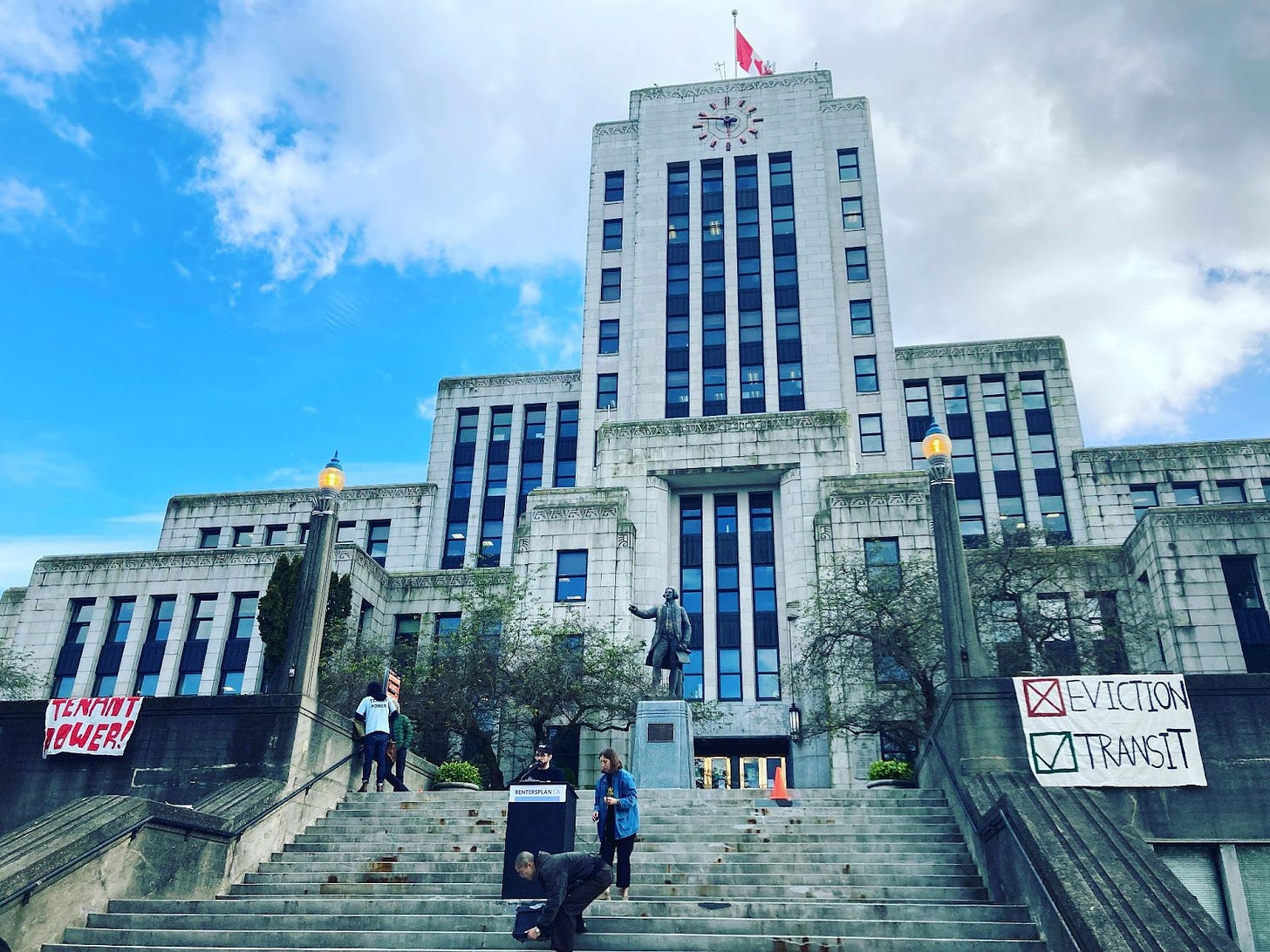After a brief sabbatical, The Thorn is back. To get involved with helping produce this socialist newsletter, email us at editor@thethorn.ca
Night of the Long Amendments: Broadway Plan saga continues
Last night City Council adjourned just before 10p.m. without having made a final decision on the Broadway Plan. After several days of staff and public presentations to Council over the last several weeks, Thursday’s Council session was meant to wrap up debate and voting on the Plan. But a slew of amendments and the usual verbosity of lone NPA Councillor Melissa De Genova meant that debate could not be completed and will resume June 22.
Notable amendments passed included OneCity’s Christine Boyle push for a bike lane on Broadway, which had the support of all councillors except De Genova and TEAM’s Colleen Hardwick, as well as Kennedy Stewart amendments permitting tenants displaced to return at the same or lower rent.
Despite Stewart’s campaign rhetoric touting “the strongest tenant protections in Canada,” Vancouver still falls short of Burnaby and New Westminster’s tenant protections and the Broadway provisions are not in line with the Vancouver Tenants Union’s call for real vacancy control on the 20% of units in new buildings which will be deemed “affordable.” If a displaced tenant accepts a buyout, or returns to their building but then leaves, the “affordable” unit’s rent could be hiked significantly since the formula allows for rent to be reset at city-wide average rent minus 20% with each new tenancy. This is not real rent control, meaning that the thousands of existing actually affordable rental units can essentially be grandfathered out of existence.
Provincial
B.C.’s Heat Dome report fails to meet the urgency of our moment
The Thorn is republishing in full this powerful statement of dissent from disabled writer Gabrielle Peters, who was invited to join the B.C. Coroner’s heat dome review panel.
I was appointed to be part of the BC Coroners Death Review Panel on the heat deaths that happened in summer of 2021. My name does not appear on the final report but I would like to offer this statement about the report for those who are interested.
My concern first and foremost is ensuring the report fulfils the mandate of a Coroners panel.
According to the BC Government website: The Coroners Act provides the chief coroner with the discretion to establish death review panels to review the facts and circumstances of deaths to provide the chief coroner with advice on medical, legal, social welfare and other matters that may impact public health and safety and prevention of deaths.
I do not believe this report fulfills its mandate for the following reasons:
The recommendations sole immediate focus on alerts, communications and wellness checks only make sense if no one died as a result of their inability to escape the heat as opposed to their own ignorance or refusal to do so due to lack of knowledge and information. I do not believe we have the evidence to support this conclusion and my own lived experience conflicts with such a conclusion.
There is no recommendation for funding air conditioners via the existing infrastructure of the BC Medical system this summer. The medical equipment program is already in place, has its own assessment and qualification criteria, and is well known to BC healthcare professionals and low income people who have required medical and mobility equipment. A reminder that the federal government announced CERB within two months of the beginning of the pandemic. It has been almost a year since the heat dome. There is no recommendation for funding for hotel rooms or that any priority be given to setting those aside for high risk populations. There are no recommendations that create new options for people to escape the heat in 2022 that did not exist in 2021, the year that 619 people died in one week as a result of the heat.
By listing medical conditions and not including the broader category of disability, (the word disability does not appear once in the final report), the report indirectly implies a causal link entirely to the presence of comorbidity and not the social and political factors that disabled people experience. While it is important to identify which specific groups of disabled people died, meaning which diagnoses, it is wrong to not assume that the medical condition itself was the only or even primary reason. Disabled people exist in an ableist society and how that impacts our lives is complex and often overlapping. For example, a particular group - or diagnosis - of disabled people may face greater stigma and less access to resources in certain situations.As well, disabled people often have more than one condition or disabilities, some may be rare or the combination may be rare, and therefore basing it entirely on prevalence of a specific diagnosis fails to capture vulnerability and risk. And finally, by failing to identify disabled people as impacted by the heat dome, the recommendations deny disabled people the human rights and other legal frameworks and protections which have been created specifically because we are recognized as a marginalized population that experiences specific forms of discrimination.
The recommendations fail to meet the standards outlined in the United Nations Convention on the Rights of Persons with Disabilities, which Canada has ratified. “Article 11 on Situations of risk and humanitarian emergencies, pays particular attention to the obligation of States parties to undertake “all necessary measures to ensure the protection and safety of persons with disabilities in situations of risk, including situations of armed conflict, humanitarian emergencies and the occurrence of natural disasters.” Further more, Article 4.1, states that “States Parties undertake to ensure and promote the full realization of all human rights and fundamental freedoms for all persons with disabilities without discrimination of any kind on the basis of disability” and Article 32, recognizes the importance of international cooperation to address the limited capacities of some States to respond to situations of risk and humanitarian crises.
The incidence of disability increases with age. By disaggregating by age and failing to do so based on whether they are disabled or non-disabled, the report could lead to additional support for people of older age who may not in fact face greater vulnerability as a result of not being disabled, not having a low income, and/or not lacking access to cool air. While simultaneously failing to identify or create support for disabled people of other ages who face heightened vulnerability due to a combination of social, political and physical factors. There is an overlap between age and disability but by focusing entirely on age there is a failure to include all disabled people who face heightened vulnerability in the catchment, whereas by including or even focusing on disability, people across all ages who faced heightened vulnerability would be included.
The recommendations assume that all those with heightened vulnerability to heat have existing and ongoing connections with healthcare professionals and other supports. Approximately 1 million people in BC do not have a family physician. Mental health services discharge clients for non-compliance. There is simply no services or availability for support for some, many remain undiagnosed or misdiagnosed, and others have deliberately distanced themselves from healthcare and social services due to the trauma resulting from previous experiences with them. The likelihood of not being connected to health and social services is probably higher among those who are, or who have been made, extremely vulnerable to the effects of heat. This also ignores the way ableism operates in seeking help and within helping professions including healthcare. As was discussed in The Lancet in a paper titled, Disability, A Neglected Public Health Issue: “People with disability commonly face barriers such as lack of transportation, inaccessible health-care facilities and non-disability-friendly equipment or procedures. Health-care providers too often lack the skills to meet the specific needs of people with disabilities or general awareness training to ensure that people are treated well and fairly. Health-care workers may fail to look past a person's disability to see other, unrelated health-care needs.”
The recommendations failed to properly disaggregate data based on race which other research clearly identifies as a factor leading to disproportionate risk and increased vulnerability during extreme heat. While it did identify Indigenous people, the report and subsequent recommendations do not recommend measures to address specific risk resulting from historical and institutional racism, particularly anti-Black racism.
The recommendations failed to identify how vulnerability can be socially constructed and worsened and how policy either supports or fails to create resilience. In this way the recommendations are very individualistic. It is the government’s job to operate an alert system, to potentially send someone to tell them to stay cool, but abandons those who are most vulnerable and lack the resources to access the means to do so. It is a little like sending the fire department to tell you to get out in a fire and doing nothing to help those who can’t use the stairs escape or attempt to put the fire out. If a person gets severe frostbite due to walking shoeless in sub zero temperatures, the problem is not that the person has feet but rather that they did not have shoes. Also worth noting, that I, as a wheelchair user, would be less vulnerable to the impact of the cold ground on my feet.
The recommendations ignore the recommendations of the World Health Organization (WHO), the United Nations, (UN), and other leading international bodies and organizations around extreme weather resulting from climate change and the needs of disabled people. ““People with disability experience multidimensional inequalities (WHO 2011) and are particularly vulnerable to climate change (Cardona et al. 2012). The findings of this review are that a broad range of personal and environmental factors contribute to the vulnerability and adaptive capacity of people with disability…Female gender, uncoupled or living alone, low incomes, nonwhite ethnicity, and nondominant cultural background are personal factors contributing to vulnerability that point to the inequalities that people with disability experience. This finding reinforces the IPCC’s (2014) conclusion that people who experience marginalization in society are likely to be highly vulnerable to climate change. People with disability may be particularly vulnerable because disability is more prevalent in vulnerable populations, such as those on low incomes and ethnic minorities (WHO 2011).”
“The United Nations (2011) Convention on the Rights of Persons with Disabilities affords people with disability the right to protection and safety in situations of risk, such as during natural disasters…Systems designed to assist people in times of emergency, in particular, are often inaccessible to people with disability. The evidence presented in this review shows that both environmental and personal factors contribute to the vulnerability and adaptive capacity of people with disability. The environmental factors demonstrate the need for responses that are inclusive of everyone. The personal factors illustrate the need to address the problem of multidimensional inequalities.” Factors Associated with the Climate Change Vulnerability and the Adaptive Capacity of People with Disability: A Systematic Review.




